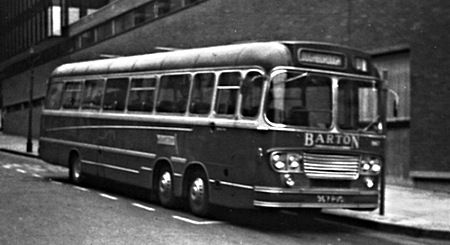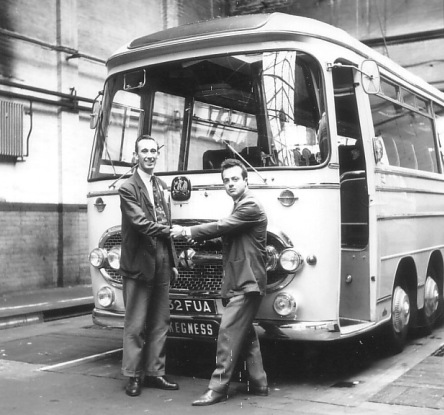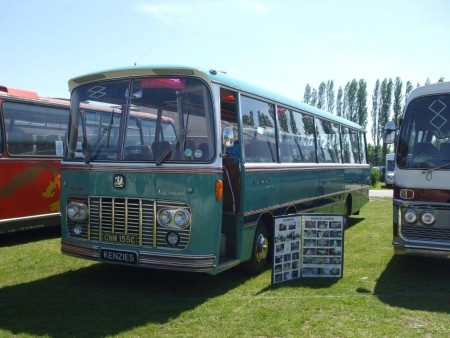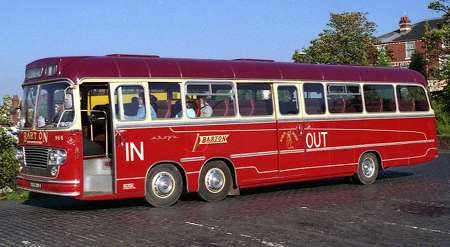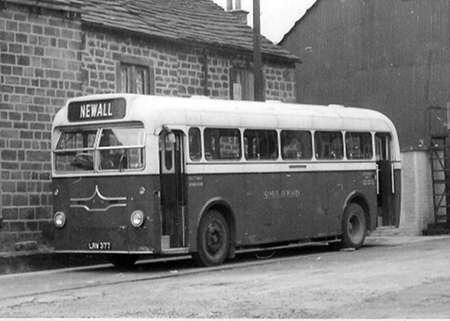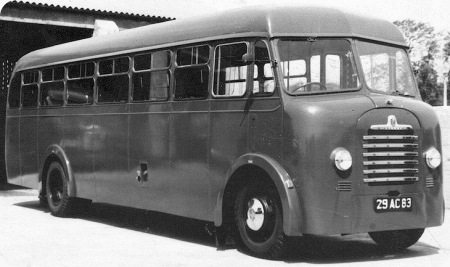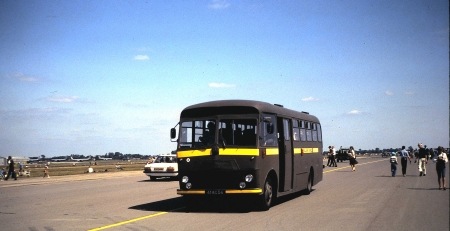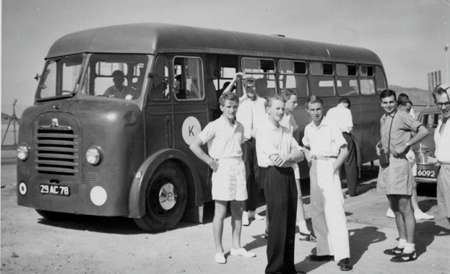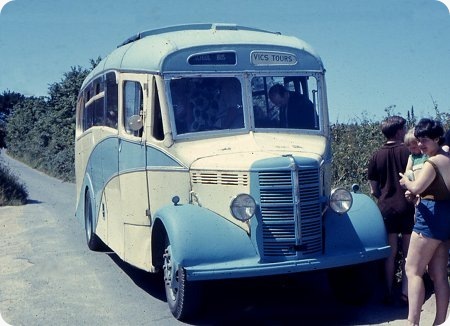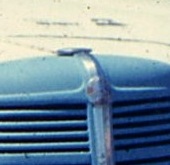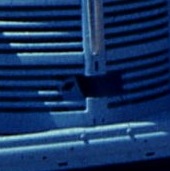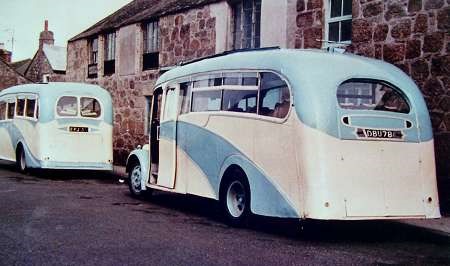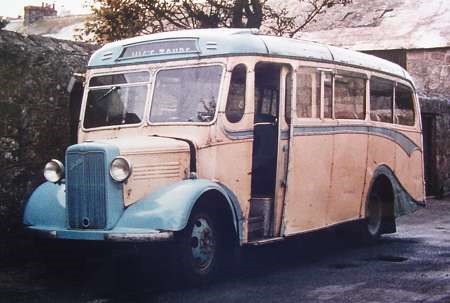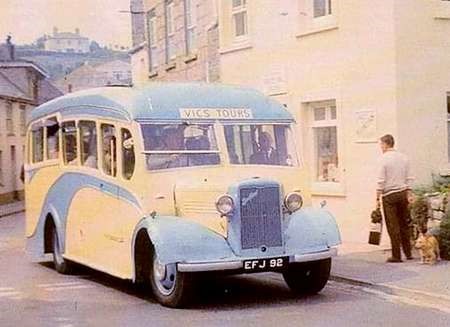Barton Transport – Bedford Val – 991 VRR – 991
Barton Transport
1964
Bedford Val14
Harrington C52F
The picture shows Barton no. 991 (991VRR) operating on the long established route 9, Nottingham – Skegness service. 991 was a Bedford VAL14, chassis no.1429, supplied new in April 1964 (it says here!) It was one of a series of eight (989-996). A 52 seat Harrington Legionnaire Mark 1 coach body no. 2948 was fitted. At the risk of stating the obvious, it was a three axle vehicle, with the front pair of axles steering. I was 15 when they were introduced, and I and my mates considered them a bit exotic.
I am not sure of the location, but suspect it is probably Skegness, and it looks to be a lovely day for a trip to the seaside. "Skegness is so bracing" – sometimes damp as well!
The Skegness run was probably the earliest long distance service operated by Barton, going back at least to the 1930s. Its route number was not distinguished by an “X” but mixed in willy-nilly with Nottingham area locals, presumably in their order of introduction. (5 Derby, 6 Keyworth, 7 Epperstone, 8 Oxton, 9 Skegness, 10 Loughborough, 11 Coalville, 12 Leicester). For a good number of years the service actually started from Long Eaton, and I think on peak dates Derby). It competed with Trent’s X3, which I believe took a slightly different route.
Skegness was a standard destination on Barton’s blinds, including the double deckers, and there are many published pictures showing that double deckers (plural) were, in fact, often deployed on the route on Summer Saturdays. The well-known Duple bodied front entrance Leyland PD1s were particular favourites. They might be regarded as underpowered for such a long run, but it was actually pretty flat across east Nottinghamshire and Lincolnshire. Although I never saw them doing it, I can well imagine them cantering along the long straight across the fens from Sleaford to North Kyme at 45+ mph emitting the distinctively raucous bark from the exhaust.
The refreshment and “comfort” break was always at Billinghay (where we happened to live from 1995 to 2003). My mother could remember travelling to Skegness on the 9 in the early 1930s, and stopping there at the Coach and Horses, where there were public toilets of the “earth closet” variety, with what I will delicately call “multi-position bench seating” ! In the last years of separate Barton existence the comfort break was moved across the road at the Golden Cross.
Copy contributed by Stephen Ford
04/12/11 – 07:58
When the VAL was taking off, people automatically gravitated towards the Duple and Plaxton offerings. Not so Barton, who not only bought Harrington Legionnaires – not Harrington’s finest hour – but also had VALs with some of the last Yeates bodies built (and with TWO doors!)
David Oldfield
04/12/11 – 10:32
Not forgetting the TWO handbrakes eh David?? I could wax lyrical for hours on the Bedford VAL which I considered to be a well designed, very comfortable and delightful vehicle with glorious sound effects to complete the enjoyment for the enthusiast passenger/driver.
Chris Youhill
04/12/11 – 11:43
Re: the location of the photo. I think in fact it is the old Broad Marsh bus station in Nottingham – the open-air version which disappeared in the early 1970s when the current station was built.
KC
05/12/11 – 06:35
The location is definitely Broadmarsh, the only reason I know that is because I’ve been searching photographs recently and if you look to the left of the windscreen, you will see a sign, GEOR– and through the windscreen PRINTERS, this was George Lomas Printers. This prompts me to ask if anyone can help with a query; the problem with old Broadmarsh was that every picture presents a different image, depending on the angle of the shot. We know that the stands were built in a horseshoe shape but in it’s last days, were they re-arranged so that they were parallel to Canal Street? I believe that Collin Street existed but it was nothing like the very busy road it is today. Would I be correct in thinking that old Broadmarsh was altered so that Collin Street could be widened and to allow work on the shopping centre and new bus station to begin?
Chris Barker
05/12/11 – 06:37
Yes, the Yeates bodied vehicles were themselves of two sorts – four with C50D bodywork, the remaining three with DP56D. How did they get the extra six seats in? Well, rearward of the central exit door the seating was 2+3 across the width, like suburban trains. They were used on normal crew operated stage carriage services. The aisle at the rear was very narrow, and when the triple seats were fully occupied, passengers on the aisle side were rather vulnerable to a smack in the ear from a passing Setright ticket machine!
Stephen Ford
05/12/11 – 11:22
Re: the two points made by Chris Barker…… In my previous post I included a link which seems to have been missed off the actual posting. This photo //www.picturethepast.org.uk/one shows the buildings behind the VAL and confirms the location.
On the question of the shape of Broad Marsh – the original version was indeed horseshoe-shaped with buses loading on the outside of the horseshoe. When the Broad Marsh area was being redeveloped in the late 60s, the bus station was changed but not parallel with Canal Street. It became two or three long platforms at right angles to Canal Street (parallel with the old railway viaduct).
This photo //www.picturethepast.org.uk/two it isn’t brilliant but it shows the point fairly well
KC
05/12/11 – 14:33
If I remember rightly the Yates bodied VAL’s with there dual doors had in large white lettering IN and OUT on them
Roger Broughton
05/12/11 – 14:38
Is this one of the Yates bodied VALs it is another shot from John Turner unfortunately I cannot make out the registration.
05/12/11 – 16:41
Yes, it could be 964 RVO bought new in 1963
Roger Broughton
05/12/11 – 16:41
The "IN" sign is clearly shown in a snap at //www.sct61.org.uk.
Mike Grant
06/12/11 – 06:42
The VAL’s were a strange choice of vehicle for the duties involved. Even on inter-urban services with limited numbers of stops, the two sliding doors which I assume where manual, must have been a pain for the conductor and unworkable with omo.
But then Barton was one of those type of operators that frequently defied the ‘norm.
Philip Halstead
06/12/11 – 06:43
It is lovely reading the various comments about Barton’s Route No.9 to Skegness. We lived in West Bridgford and caught the service at Trent Bridge outside Saxby’s the newsagents. I cannot remember the technical details of the coaches but they were very comfortable. About 2 months ago I took my daughter and grandson to Woodhall Spa and we stopped at the ‘Coach & Horses’ as I pointed out to them the excitement of knowing that we were about half-way to Skegness! Being of the modern generation they probably did not understand. I have a photograph from that trip but do not know how to include it!
Alan Rose
06/12/11 – 08:46
Chris Y, can enlighten us to how the two handbrakes operated
Roger Broughton
06/12/11 – 15:32
Certainly Roger. As far as I can recall, there was one in the region of the underside of the dashboard and that was operated by a smallish chrome lever with a very positive action. The other was a much larger lever, with button release in the end for the thumb to press, in a central position adjacent to the central engine bonnet cover. One of them was a normal handbrake operating on the rear brake drums, while the other worked by grasping the prop shaft. Egg on my face now, because much as I loved the VALs I can’t remember which was which – it is 42 years since I last drove a VAL !! On balance though, I think the small one was the normal parking brake while the larger "progressive" one was for extra retardation at busy times. I’d be glad if someone can settle this little point for us – one thing though is certain and that is that it was quite common for the uninterested element to do a few miles with one brake still applied before the penny dropped that the engine was not ailing and "pulling bad", to use that sloppy slang expression.
Chris Youhill
07/12/11 – 06:56
Chris, would it be similar to a Telma retarder?
Roger Broughton
07/12/11 – 10:18
Well Roger, without doubt the effect would be the same, to slow the vehicle without undue strain on the brakes, but there the similarity ends. The Telma is a sophisticated electronic device which can be applied in specific driver selected stages, but the VAL’s second handbrake was a purely mechanical affair. I’m still at a loss to remember which brake did what on those fabulous vehicles. The Barton dual doorway service buses were a model I’ve never before heard of and are delightfully eccentric but no doubt functional. Other wonderful VALs were the North Western "low height" or "Beverley Bar" ones made for use under the Dunham Bridge ?? viaduct- these gave a rather whimsical imitation of the roof lines of London underground stock I always thought.
Chris Youhill
07/12/11 – 10:35
Chris’s mention of the VAL brakes reminds me of a time I rode in a Wallace Arnold VAL during a post-maintenance test run, driven by the Chief Engineer. He was very impressed with the VAL’s keen brakes and every time we past a female pedestrian he would apply the brakes sharply, causing the nose to dip alarmingly – accompanied by the announcement "Bow to the Lady!".
Paul Haywood
08/12/11 – 06:34
I drove EUG 914D ex Wallace Arnold at Stanley Gath Coaches of Dewsbury. The second hand brake was by the steering column and the handle edge stuck in your leg. The brakes were never up to the job and after they got hot squealed a lot. I was always complaining to our mechanic to adjust them so it was somewhat relieving to be promoted to a Bristol LH.
Philip Carlton
09/12/11 – 08:19
How interesting it was to stumble on the articles on the Bedford VAL. I drove one of these in the early 70`s. But what amazes me is that someone remembers about the two "parking brakes". The one I drove, I believe an early one, had the retarder handle on the right and the handbrake on the left of the driving position. The retarder handle had a red tip to the lever. I saw a later VAL that was fitted with a Telma, as fitted to later Bedfords I drove. The reason for retarders on these VAL`s was because the brake linings were so small, due to the 16" wheels and narrow linings, that brake fade was a regular occurrence. But something else that a lot of drivers also forget about the VAL, is the Turner "Chinese" 5 speed gearbox that some were fitted with. I can`t remember the shift pattern now, but it was really odd, with I think only 5th in the normal place. It was even more weird than the Bristol Lodekka 5 speed box, with it`s 5th after going through 4th.
Brian K
09/12/11 – 08:25
Philip, I’m sorry that you were so unhappy with the VAL – suffice it to say that when the large number of these were with Wallace Arnold there was no trouble with squealing or inadequate brakes so that’s a bit of a mystery.
Can you please though remember the functions of the two handbrakes ?? I’ve been trying to clear my failing memory, and now I’ve decided that the large one to the left of the driver was the normal one, while the little second one was the device for extra security by locking onto the propshaft ??
Chris Youhill
09/12/11 – 10:28
Brian. The weird "Chinese" 5 was on the early VAL14 (Leyland 0.400 engined) model – which most people now recon was better than the later VAL70 with the Bedford’s own 466 engine. As far as I know, the Bedford engined version had a fairly conventional gate pattern. If I can remember rightly – but I don’t swear to be right – the pattern was something like this:
| 2 | 5 | 1 |
| 3 | 4 | R |
I cannot recollect the functions of the two brakes – can just remember one being like a Morris pull up handbrake and the other like a Vauxhall umbrella type. Telmas were certainly fitted at a later stage to overcome brake inefficiency. The first one I came across was on a Burton/Brixham coaches VAL14/Marshall bus plying its trade between Brixham and Kingswear (for Dartmouth). The driver obviously knew what he was doing but I was very impressed by the way the Telmar aided safe negotiation of the hilly and winding road between those two places.
David Oldfield
10/12/11 – 07:27
As far as I recall the small one by the steering column was as you surmise locking on to the transmission and the other one was the normal handbrake.
Philip Carlton
10/12/11 – 12:22
Many thanks David and Philip for those helpful recollections which have sorted this matter out. I had also forgotten that reverse and first (crawler) gears were on the right of the gate – and certainly the normal four ratios were indeed as David recalls on the "Chinese" early versions. Philip also confirms that the small chrome handbrake lever, also on the earlier vehicles, was a purely mechanical device on the propshaft – again I had forgotten that later versions of the VAL had electric Telma retarders.
Myself (thin) and a fellow driver posing for a mock "handing over" ceremony of the first of the initial batch of three Bedford VAL coaches (132/3/4 FUM) for Wallace Arnold in 1963.
Chris Youhill
16/12/11 – 08:18
The first coach I drove after passing my PSV test was a Bedford VAL14/Plaxton Panorama KMC 628C for A L Moore of Sleaford, Lincs. The small handbrake on the steering column worked on the propshaft and the large one next to the bonnet was the normal handbrake but, unusually worked on the front axles, not the rear! The ‘chinese’ gearbox was fitted to the VAL14 with the Leyland engine whereas the ‘normal’ pattern 5 speed box was fitted to the Bedford engined VAL70. I remember Bartons VALs coming through my home village of North Kyme on their way to Skegness. Thanks for the memories!
Richard Hill
30/01/12 – 07:36
Fantastic machines I remember in my childhood going to the east coast in Leyland engined VAL"s run by Heaps Tours Leeds (anybody remember them I would be grateful for any info). The climb up Garrowby Hill usually produced some spectacular sound effects.
Tony Greig
31/01/12 – 08:03
The VAL14 in my view produced the purest of all Leyland O400 sound effects, very nicely captured in The Italian Job. (I never travelled on a VAM14, so don’t know if the sounds were quite the same.)
Peter Williamson
31/01/12 – 09:28
Tony I think most older folks in Leeds will well remember Heap’s Tours – a much respected operator who later adopted the title "Heaps Leopard Tours" and had a full picture of those noble animals on many vehicles. I seem to recall that Heaps took over Rogers of Leeds at some stage. The Heaps depot was next door to the Lyric Cinema in Tong Road – a building whose red "Lyric" neon sign remained lit at times long after the cinema closed.
Chris Youhill
31/01/12 – 09:29
Yes they were, Peter.
David Oldfield
31/01/12 – 15:23
Heaps were my local operator as a lad living a few hundred yards from the Tong Road depot which still exists but is now a car mechanics. They had an illuminated sign over the travel office showing an AEC Regal with a Duple body. They bought both Bedford Vals including one with a Harrington Legionnaire body. Later they caused me some personal amusement as they called themselves Leopard Tours but ran AEC Reliances!
They eventually became part of the Trimdon Motor Services Group and gradually faded away.
Originally their colours were green and cream but this changed to blue and cream in the 1960s.
Chris Youhill mentions Rogers of Leeds they were blue and cream and sported a boot logo of an illustration of Leeds town hall
Chris Hough
06/02/12 – 15:03
I drove for Seaview Services on the Isle of Wight for a number of years when on occasion I was allocated a VAL – which I hated! I found the driving position too low, while the steering was almost TOO responsive. I much preferred the YRTs, one of which was fitted with a TELMA – for the hilly bus route between Ryde and Seaview. The trouble was that it used to drain the battery very quickly – so I only used it when absolutely necessary.
Ian L Jamieson
Many thanks Chris Y and Chris H. I can vaguely remember the green and cream livery and as I became more aware of what vehicles they actually ran the idea of an AEC Leopard amused me too. I also recall when Trimdon took them over and they actually did employ Leopards, but as an operator they just seemed to "wither on the vine". By the early 80"s I had formed other interests away from bus, coach and railway subjects (girls beer and rugby to be precise!) so it was a case of one minute they were there and the next minute they were gone.I should have paid more attention.
Tony Greig
23/04/12 – 06:04
Yes, the small chrome handbrake lever next to the steering column was indeed a transmission brake and whilst the bus moved with it on there could be disastrous consequences to the transmission. Besides the Yeates twin door buses (which did have power doors) and were not used with conductors we had two Plaxton coaches 971 and 972 at Long Eaton garage used mainly on the service 3/3c but on longer distance routes such as Leicester/Nottingham – Morecambe on Saturdays (I was on both these services in the late 60’s) A further one was 970 at Chilwell garage and two more were added to the fleet with the takeover of Hall Bros of South Shields. There were also 5 AEC Reliances with the Yeates dual door body although in later years the centre entrance unlike on the VAL’s was taken out.
Peter,C
24/04/12 – 06:57
Since this subject has been re-visited, I thought I’d mention the fact that when Barton’s were ready to dispose of these vehicles in the 1970’s, the whole batch of eight were advertised in the local paper, the Nottingham Post. I remember thinking, what a very strange thing to do, the thought of the average Post reader buying eight Bedford VAL’s!! I kept the clipping of the advert for many years before discarding it. How I wish I had it now to post on here!
Chris Barker
01/05/12 – 07:12
Hi KC and Chris B. There were several stages of development connected to the ‘open air’ Broad Marsh bus station. The latest being the platforms parallel to the GCR railway viaduct about 1969/70. I’ve not been able to establish when a bus station was first established at this location. The site was cleared of slum housing prior to 1939 so I imagine that the bus station was established in the late forties/early fifties. Examination of large scale OS maps and photos shows that initially there was only a semi horseshoe platform. My particular interest is with the Clifton services from when these were introduced in October 1952. At that time the Cliftons used a stand on the west side of the bus station (from where at a later stage the MGO services to Hucknall departed). The next stage was to construct a platform parallel to the railway viaduct for the Cliftons (circa 1954/55). The next stage was the full horseshoe but with the loading taking place inside the horseshoe with buses moving clockwise around the horseshoe. The last stage of the horseshoe was with loading taking place on the outside of the horseshoe (so buses moved around the horseshoe in an anti-clockwise direction). The Clifton services unloaded passengers at a separate layby adjacent to Widdowson’s factory before moving to the parking area inside the horseshoe (if a layover was being taken) or to the departure platforms to load. This change took place from 1st February 1959.
Michael Elliott
02/05/12 – 08:59
That’s very interesting information Michael, I’ve looked at a great many views of Broadmarsh and whilst the majority of them are self explanatory, there’s always one which is confusing. I wonder if you’re familiar with the book ‘Buses in the Sixties’ a Venture publication by John Banks and the late Geoffrey Atkins which contains many Nottingham pictures. On page 61, there is a shot of a South Notts PD2 on the 68, on the offside of it, an NCT PD2, also on the 68 but seemingly on layover. Behind them is an MGO Lodekka, presumably on the Hucknall service. The roadway appears to be straight but it isn’t parallel with the viaduct because there are many buildings in the background. This ties in with your comment about the Clifton services sharing a stand with the Hucknall service, the problem is, it’s dated June 1969. I’ve been to Nottingham Library and looked at the OS maps but I’ve still not been able to conclude this one satisfactorily!
Chris Barker
09/05/12 – 07:39
Returning to the original subject, I have to confess to being a bit of a fan of the Harrington Legionnaire. The grille is a disaster area of course, there’s no point in denying that. And this particular example, with sliding vents in the windows and six wheels, isn’t the best. But with forced ventilation, and on a Ford chassis (whose larger wheels broke the trim twice rather than half of it three times), it was one of the cleanest designs of its time, and in fact well ahead of its time if you compare it with the offerings of the likes of Van Hool up to 20 years later. //www.flickr.com/ I understand that when Harrington went out of business they were in the early stages of planning to replace the Grenadier with a new model based on the Legionnaire. It already has the Grenadier windscreen, and with no radiator at the front of underfloor engined chassis, it could have been given something like the the Grenadier dash panel in place of the grille.
Peter Williamson
09/05/12 – 19:29
As a big fan of Van Hool for both their understated timeless designs and for their unassailable quality, I can see what you mean about the Legionnaire. …..and yes, pity about the grill.
Whilst it is true that generally only quality firms survive it is also true that, sadly, quality firms die through no fault of their own (AEC and Bristol) or because they temporarily lose the plot (Burlingham and Harrington) never to regain it. It takes years to build up a reputation and minutes to destroy it!
David Oldfield
10/05/12 – 07:31
I agree with your comment about reputations David, but there are two opposite ways, aren’t there, to that fatal few minutes –
1. Stubborn decision to cling to a tried and tested product that has passed its sell-by date (Gardner was mentioned on another thread recently);
2. Thrusting, dynamic decision to strike out with a new product that just doesn’t cut the mustard. The former is like trying to stop water from running downhill, and the latter is like trying to make water run uphill!
Stephen Ford
10/05/12 – 11:17
Too true, Stephen.
I suppose, in one way, Burlingham was a case of 2nd scenario. Couldn’t better the original Seagull and tried to recapture the market with more and more bizarre offerings until the customers could/would put up with it no more.
David Oldfield
11/05/12 – 08:07
I bet someone can tell me why the VAL had those three axles. Length requirement? Easier turning of length because there was then no rear steer on 3 axles (except a second man sitting over the axle at the back!) Owner vanity? Product differentiation (meaning a styling gimmick, which GM knew all about) Or…..?
Joe
11/05/12 – 09:36
Did Harrington "temporarily lose the plot"? The Cavalier and Grenadier were the best things they ever did, and the Crusader had never been a big seller anyway. From what I have read, their problems stemmed from a shrinking market, their non-core work drying up (e.g. Sunbeam Alpine), and having no capital available to either develop new models or get out of their cramped and old-fashioned factory.
Peter Williamson
11/05/12 – 11:59
Peter, I think you’ve answered your own question. The plot is not necessarily the core activity (like designing a coach) but the other important but less exciting things like financial and business matters and reading the market ahead!
David Oldfield
23/05/12 – 16:58
I’ve just heard about a new sculpture which is to appear hanging over the edge of the roof of the De La Warr Pavilion in Bexhill at the end of June. It’s a life size model of the Harrington Legionnaire bodied Bedford VAL which was used in the 1969 film The Italian Job. The sculpture is called Ang On Lads I’ve Got a Great Idea. Anyone who has seen the film will know why.
Peter Williamson
31/05/12 – 08:14
I worked as a mechanic at Heaps tours from 1968 to 1972. The Val did indeed have the main handbrake working on the front 4 wheels, operated by a large ratchet lever. The umbrella type pull out handbrake (like on some ford cars of the 60s), worked a drum brake on the propshaft. Heaps Vals had Leyland 400 engines, which I fitted exhaust brakes to, to save on brake shoe wear, as one of the hills down south was 6 miles long, so I was told, brakes on all the way. The exhaust brake was operated by compressed air and nearly shut off the exhaust system causing the engine to be a compressor, as most of the exhaust gases could not escape. I have had some fun working on the Bedford Vals.
David Green
05/06/12 – 08:36
The "Harrington Gathering" was at Amberley, Sussex, Sunday (3 June), with an impressive collection of vehicles. There was a VAL/Legionnaire booked to attend, CNW 155C, but it didn’t make it. This particular vehicle is with Kenzie’s, and was new to Heaps.
Pete Davies
06/06/12 – 10:03
This is the former Heaps Harrington bodied VAL. It appears to be in excellent condition, and was photographed at the AEC Centenary Rally at Newark Showground on 27 May 2012. (The Rally had a number of non AECs present).
Bob Gell
12/12/12 – 15:50
The Val parking brakes were interesting. It needed two because of the regulations on the weight which had to be braked by the parking brake. As previously mentioned the big lever on the left worked on the drums on the four front wheels. This brake was safe to be applied whilst moving and would also hold the coach when the wheels were on ice. The umbrella worked the drum on the transmission at the diff. It could not be used when moving.Parking only and was effective but!! if it was parked on ice the wheel on the ice would slip on the ice and allow the wheel off the ice to rotate and the bus would move off down the hill. Neither of them were retarders. A Telma was fitted to many. If the brakes were correctly adjusted they were perfectly OK but most mechanics didn’t know the trick on how to adjust them to get the best. Mine were fine once I used the Bedford "new lining set up procedure" every time I adjusted them and used the Telma retarder intelligently.
John Watson
13/12/12 – 06:16
Whilst the Harrington bodied VALs were heading to Skegness, the Yeates bodied fleet headed off to Blackpool.
I recall regularly seeing both single and dual doorway versions on the A6 in Stockport and Manchester. They were probably the most exotically bodied VALs in the UK.
I don’t recall the Harrington bodied VALs operating to Blackpool but that doesn’t mean they didn’t – perhaps they didn’t make the same impression!
As to an earlier query about why there were three axles, in the year the VAL was launched Bedford ran a half page ad in some national dailies and regional evening papers at the time of the Commercial Motor Show to extol the VAL – a seemingly strange thing to do, foreshadowing Barton’s ad to sell their fleet.
The ad stated something along the lines of "two steering axles for cornering stability and smoother riding", the latter an interesting claim given the 16 inch wheels.
Three axles certainly were not a legal requirement.
Phil Blinkhorn
13/12/12 – 10:30
Yes Phil, the VAL was indeed a "surprise" development but nevertheless, as a driver and as a passenger, I found them extremely stable and, as the advert claimed, most certainly superbly smooth riding. If one unavoidably went over an unfamiliar defect in the road the VAL sailed on unperturbed, the only clue being a rather endearing little rubbery sound as both front axles passed over the fault. Better stop now before folks think that I was besotted by the model – well I was – I loved them.
Chris Youhill
13/12/12 – 14:40
The only VALs I ever rode on were North Western’s special Strachens bodied vehicles with the low height, curved roof for the Dunham Woodhouses bridge.
These rattled almost from new and it was obvious when a road defect was hit. North Western only kept them until their first seven year certificate expired as body structural defects were too expensive to repair.
Stripping out Chris’s bias towards the type, there must be a grain of truth in his observations (!!) as the type was popular and many had long and useful lives.
It just shows how a limited experience of a type can influence one’s views.
Phil Blinkhorn
14/12/12 – 07:13
I’m not sure what engines were available for VAL’s or the power of them. Were they quite lively vehicles in service?
Chris Hebbron
14/12/12 – 07:13
I understand that Bedford opted for a three axle layout for their 36 foot coach to avoid having to develop ‘heavy duty’ axles, making use of existing axles from the range of Bedford lorries. Ford, on the other hand, for their 36 foot coach – the Thames 36 – developed heavy duty axles for the chassis.
Michael Elliott
14/12/12 – 08:45
Michael you are spot on with the front axle, as for the engine, I know they used the Leyland 400 but as for a Gardner 6LX I don’t think so with a front entrance.
Andrew
14/12/12 – 08:46
Originally fitted with a Leyland 0.400, after three years this was replaced by a Bedford 7.64 litre engine.
I’m not sure about Michael’s comment. The Bedford TK range of trucks produced from 1959 had a number of heavyweight versions available by the time the VAL appeared and had produced heavyweight axles throughout the 1950s for its S range of trucks.
Phil Blinkhorn
14/12/12 – 08:47
Chris. There were only two VAL models – the original VAL14 (1962-1967) and the subsequent VAL70 (1968-1973). The VAL14 had the 125bhp Leyland 0.400 (Tiger Cub) engine (6.54 litres) which was replaced by the 143bhp Bedford 466 engine (7.6 litres). Received wisdom is that, despite being noisy, the Leyland unit was by far the superior engine. It was never, however, going to be lively.
[For the likes of me, nothing topples a heavy-weight with AH590/691/760, 0.600/0.680 or 6LX(B) power. The extra torque was crucial.]
David Oldfield
14/12/12 – 10:50
Thx, Phil/David.
Chris Hebbron
14/12/12 – 16:11
As has been touched on already, the concepts behind the VAL were stability and passenger comfort. The use of 16in wheels meant that the resultant vehicle was extremely low-slung and therefore ha a low centre of gravity. The use of 16in wheels also meant a lack of wheel arch intrusion and a flat floor. The third axle was necessary to spread the weight — with small wheels more of them were needed. The extra steering axle also contributed to the stability of the vehicle. Passengers loved the VAL, hence its unprecedented success, but it was challenged in the power department, and with the increasing demand for heavier and more powerful coaches in the 1970s, its benefits became less important.
Philip Lamb
10/01/13 – 07:03
Found this site by accident, was a bus-spotter when a child, have no expert knowledge.
I was lucky enough to travel on a Val Vega Major owned by Bullocks of Cheadle, for a Sunday school outing to Blackpool from Stockport. It has been my favourite coach ever since. Sad to see it derelict on the Wakefield Files website.
My eleven-year-old imagination caused me to ‘design’ a long-distance coach for Britain’s fledgling motorways, with two rear axles and three at the front! (A Chinese ten?). I have now seen a picture of a double-decker with such an arrangement on the ‘net.
Thanks for helping me to wallow in nostalgia.
Malcolm D
08/02/13 – 06:23
Baryons used to use these on service 18 Beeston Rylands to Ilkeston and beeston Rylands to Nottingham I was a conductor with Baryons in the late 60s and worked that route that’s how I met my wife who lived in Beeston Rylands I later became a driver and on occasions they did go to Skegness on the express service.
Geoff Conway
27/04/13 – 15:43
The comment about being challenged in the power department is all too accurate – but then, with a Tiger Cub engine in a 36 footer, they could never be anything else. In the VAL’s case, the weird choice of gear ratios did nothing to help. The gap between 3rd and 4th was so big that on even a modest hill, changing up to 4th was a waste of time. By contrast, 5th was barely higher than 4th. Perhaps there was a good reason for this but I can’t think of one.
Bob Hunter
29/04/13 – 08:01
The 5-speed gearbox on the VAL seemed to be an early attempt to get to grips with motorways while recognising that most drivers would always start in second gear on level ground. Consequently first was little more than a crawler, second was for moving off, fourth (direct drive) for normal cruising and fifth (overdrive) for fast roads and motorways, leaving a huge gap for third to fill.
There was an alternative gearbox listed – a 5-speed close-ratio direct-top unit for bus work – but I don’t know if any were actually built.
Peter Williamson
26/10/13 – 08:00
Adding to the comment about two-doorway examples, here is a shot I caught at Kidderminster, Severn Valley Railway a few years ago with one of these examples seen from the doorway side; now how can you miss which door is which??
The SVR used to stage this superb rally early October each year, a magical mix of steam trains, lots of heritage buses and, as here, perfect weather. Sadly, this event no longer continues, I suspect mainly because a combination of car parking constraints down in the town centre/Sunday trading made unavailable the big (car park) space between the SVR and “big railway” stations.
I liked to get there early to see the arriving vehicles, and as was the case with this one, I got pleasant surprises to see and photograph buses I never knew had survived.
Rob Hancock
26/10/13 – 17:16
Rob,
The SVR still host this excellent rally. This year (October again) at Bewdley – a station further along the line – and again enjoyed a fine day with some interesting and immaculate exhibits. Long may it continue, a great day
Nigel Edwards
26/10/13 – 17:16
Sitting in my daughter’s home in Texas on a sunny Saturday morning, Rob’s photo has immediately transported me back to Stockport Rd, Levenshulme, Manchester on summer Saturdays in 1964 when I had a summer job in a grocers and at least one of these exotic machines would pass on their way to Blackpool.
Thinking about the seating aft of the rear door, This must have been bad on stage carriage services and decidedly uncomfortable on the long haul to Blackpool.
Phil Blinkhorn
27/10/13 – 06:49
Rob – I do admire your faith in human nature, but believe me some of the travelling public are well capable of using the wrong doorways, both when boarding or alighting. At Samuel Ledgard we had and ex Daimler/Duple standee demonstrator LRW 377 which had been all over before we bought it and we purchased it as it was expected to be ideal for the busy Otley town services in lieu of a double decker. It SHOULD obviously have been ideal but, oh dear, there were battles royal within at every stop despite the rear and front doors being clearly labelled. It seated 36 with 28 standing if necessary. It was eventually put out to rural pastures on the long service from Bradford to Harrogate, with the standing reduced to eight. Then it was sold to Bere Regis and District in Dorset, who removed the rear door and increased the seating to 42.
Chris Youhill
29/10/13 – 13:27
Here is a link to a Strachans advertisement for the unique North Western VALs mentioned above by Phil Blinkhorn. www.flickr.com/photos/3 Like one or two other correspondents, I wasn’t greatly taken by the VAL. I always understood that the twin steering arrangement was the inevitable result of choosing reduced diameter wheels to reduce the floor height. This meant that the drum brakes had to be correspondingly small, so that an extra axle at the front not only helped to carry the distributed weight of the overhung engine on the small tyres but also provided the necessary increase in brake lining area. Even so, I believe that the VAL, like the PD3, needed an understanding driver where the brakes were concerned. I never drove one, and had only a few trips as a passenger, so I fully respect the much more informed comments of those with greater experience of the type. Certainly Bedford at that time tried hard with well engineered designs to meet the needs of the smaller operators. The subsequent demise of the marque was entirely the result of complacency and R&D starvation by General Motors. A new generation of Bedfords for the motorway age could easily have been developed. The Dennis Javelin was devised to meet such a demand, and it notched up respectable sales.
Roger Cox
29/04/14 – 08:20
The Bedford VAL was a second rate vehicle at Bartons, l liked them but some did not, they were a coach doing a bus job, as a lad l worked with a fitter and we fitted an exhaust brake off an AEC on a VAL 964, it was an instant success it reduced brake ware by 50 per cent. It became standard on all ours and other firms started doing the same, we stopped buying them but later inherited one when we bought Provincial Coaches of Leicester in 66 and more when we bought Hall Bros, South Shields, they all went in the 70s in PX for the new fleet of Leyland Leopards, l have driven VALs on breakdowns, service, and private hire.
Bill Redfern
06/03/15 – 16:17
I have never driven a VAL, but have travelled on several over the years. They achieved the same ride quality on Leaf springs that modern Coaches manage with Air Suspension. The Achilles heel was the brakes, which needed to be adjusted a lot more frequently than other chassis. The 16" wheels were the same size as the Bedford VAS.
Stemax1960
07/03/15 – 07:11
Readers of this site may be interested to know that this month’s issue of Bus and Coach Preservation magazine has an article about Barton Transport – Bedford VAL 966 RVO.
This is one of the Yeates bodied examples, and is now unique.
Stephen Howarth
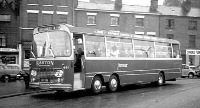 Vehicle reminder shot for this posting
Vehicle reminder shot for this posting
09/03/16 – 16:05
I have only just found this forum, I find it very interesting in as much as my last live in bus, in which I must add brought my 5 children up in, well for several years of their life. My example was a Harrington Legionnaire registration number 8750 HA formerly out of Smethwick, it was originally registered in 1964 making it a VAL14. There has been a lot of remarks made as to the brakes, some later quotes have corrected the layout of parking brakes, the small umbrella type is indeed a prop shaft brake and is not for use as an emergency brake as it can cause breakage of half shafts. The regular handbrake is a ratchet affair which operates on all four front wheels, this does in fact provide a very safe emergency brake. There was a way of getting the front brakes set up properly, this was disconnect all cables from drums, adjust the brakes then reconnect cables and adjust them to operate at the same time on all four wheels. I did upgrade mine to VAL 70 spec. which had a profound affect on stopping power, the VAL70 shoe having 50% extra width. Having driven a variety of buses and trucks over the years this was the nicest to drive, stupidly I scrapped this one in the nineties.
By the way it is right as was said, there is a beautiful sound produced from the 400 power plus.
Kenneth Hulbert
10/03/16 – 05:05
Congratulations Sir – what a very fine home for a family, and mobile too which was no doubt an advantage for holidays etc. Like you I always found the VALs of whatever marque to be a fascinating delight to drive, especially for an enthusiast. Why so many people disliked them I can’t imagine – they were adequately powered and braked, and the suspension gave the passengers a superbly comfortable ride which many "traditional" models from other makers couldn’t match. I particularly recall happily that if you unavoidably went over some unexpected or hidden road defect there was no jerking – just a fascinating aural "plupp plupp" as the four wheel front "bogie" contained any shocks incredibly well. I’d love to have a go in a VAL right now – a comfortable ride and delightful sound effects from engine and transmission – a very honest model indeed in the usual Bedford tradition.
Chris Youhill
Quick links to the - Comments Page - Contact Page - Home Page

